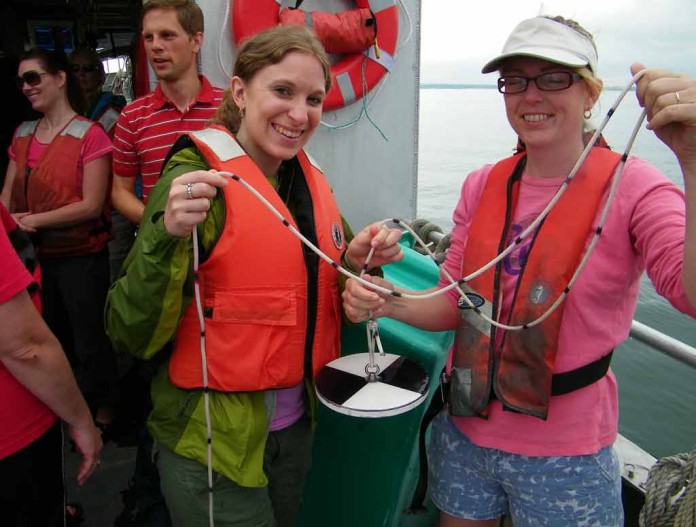
Right about … there. Right? Yep, it was gone.
I squinted in an effort to improve the accuracy of my reading. Indeed, this was the place where the black and white plate suspended from a rope, this thing that researchers refer to as a “secchi disk,” had completely disappeared from view. In an instant, it was swallowed up in the vastness of Lake Erie’s underworld.
The marks on the rope of this instrument provided me with the approximate depth that the disk became invisible, so I quickly headed to the ship’s cabin to record my turbidity reading on the scientist’s laptop.
The deeper a secchi disk can be seen in the water indicates clearer, more transparent water. If the view of the disk is lost closer to the surface, the water is turbid and contains more sediment.
Knowing this, I predicted that our group’s average reading would reflect similar results caused by the previous night’s storm. If my suspicions were true, the turbidity, or transparency, of Lake Erie would improve as we moved away from the mouth of the Huron River, who apathetically shed her heavy sediment load into the lake’s water during the storm.
Taking another reading at our next stop further from shore would confirm this speculation.
Freshwater challenges
Too much sediment is only one of our freshwater challenges. Though the roots of Ohio’s Soil and Water Conservation Districts (SWCDs) began in soil conservation, water-related issues continue to evolve and grow more critical.
The explosion of harmful algal blooms in our lakes and rivers, record-breaking rates of groundwater withdrawals and aquifer depletions, and unsettling incidents of contaminated drinking water supplies all serve as recent alarming reminders. Balancing our unquenchable water usage with our diminishing supplies and increasing contaminants proves to be a difficult challenge.
Investigating watersheds
As our demand for clean freshwater increases, so does our need for education. The Geauga Soil and Water Conservation District has developed successful and effective programs that connect educators to “the wonders of their watersheds” and with tools to investigate issues with their students.
For 16 consecutive years, the Wonders of Watersheds workshops have been providing unique, affordable training opportunities to area teachers and educators. These summer workshops — Wonders of Watersheds and the Advanced Wonders of Watersheds — give participants an in-depth look at the natural resources in the Great Lakes Region and ways to create lasting educational experiences for their students. Our watersheds provide the perfect backdrop to investigate increasingly important water quality and land use issues.
Staying true to the spirit
At the heart of the workshops is Geauga SWCD’s collaboration with Portage SWCD and Ashland University adjunct professor and retired Geauga County Educator/Administrator Nancy Speck. As an original founder, Speck continues to bring creative ideas for learning, the gift of helping others reach their fullest potential, the use of journals for effective assessment, and an undying dedication to the spirit of the workshops.
Like all good things that evolve and improve over time, this year’s workshop (June 14-16) remains the local workshop held in Geauga and Portage Counties and provides educators with creative ways to incorporate learning standards. Each participant will receive Project Wet, Project WILD Aquatic, Project Learning Tree and Exploring Streams curriculum guides.
This year’s Advanced WOW (June 27-29) is at Old Woman Creek National Estuary in Huron, and participants will receive Healthy Water Healthy People, The Wonders of Wetlands, Flying Wild, and Teachers on the Estuary (T.O.T.E.) curriculum guides.
Secrets to success
What has made these workshops so successful? Most importantly, they give teachers what they want and need: resources, relevance, credits, and fun. Throughout the workshops, educators have the opportunity to participate in numerous hands-on environmental science and biology activities led by many local resource professionals.
Whether canoeing in an estuary, exploring a forest, or identifying zooplankton, even originally reluctant participants soon embraced and enjoyed the challenges. They engage in active participation, learn methods for assessing their students, and gain confidence as they try new things through peer teaching.
In addition, they receive numerous curriculum guides, resources, and the opportunity to earn up to three graduate credits through Ashland University. These tools enable and empower teachers to engage their students in meaningful learning experiences, both indoors and out.
Bringing it home
The workshops are proven to be a successful catalyst for teachers to incorporate positive change into their teaching methods and curriculum.












